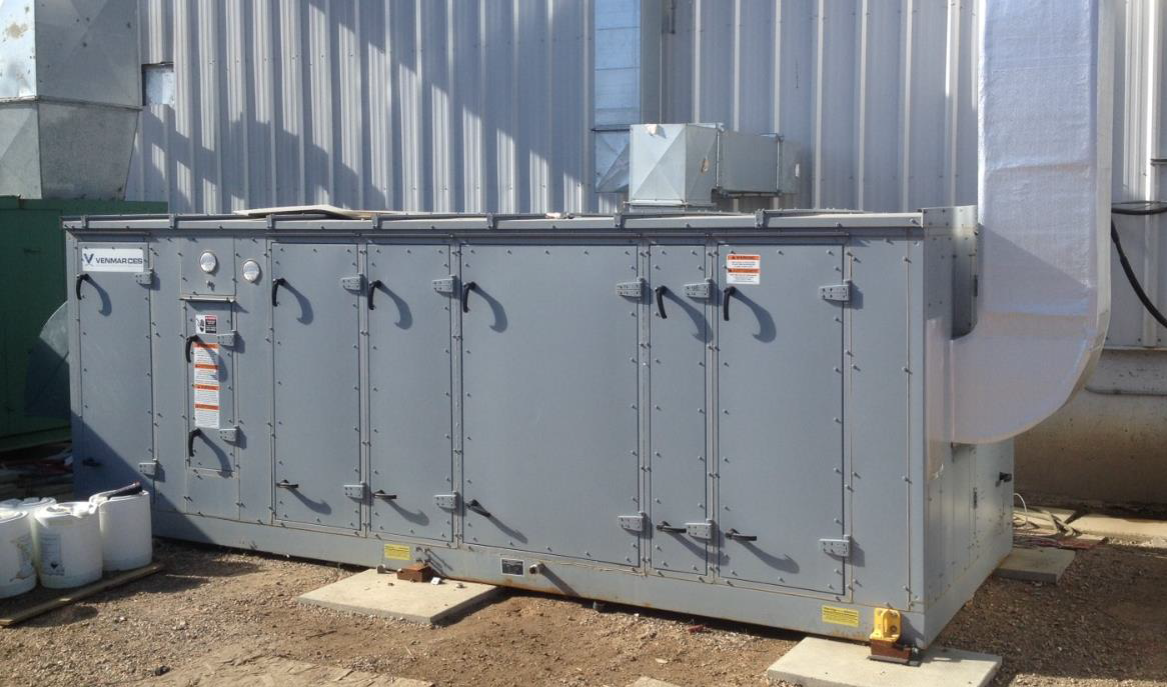Advanced Liquid Desiccant Air Handling System
Lead Proponent: Venmar CES, Inc.
Location: Saskatoon, Saskatchewan
ecoEII Contribution: $ 1,388,000
Project Total: $ 3,481,000
Project Background
The energy used to provide fresh air to a building constitutes a substantial portion of the total energy required for a building’s heating, ventilation, and air conditioning (HVAC) system. This is especially of concern in highly ventilated environments such as schools, office buildings, hospitals, and auditoriums. Liquid desiccants have long been known to be capable of conditioning air, and have therefore been used in some commercial systems. However, direct-contact liquid desiccant systems have the risk of carrying-over aerosol droplets to the supply air stream, which could cause health problems for occupants and corrosion of downstream equipment.
Nortek Air Solutions Canada Inc. (formerly Venmar CES) is a company that specializes in commercial and industrial HVAC products, with a specific focus on energy and heat recovery. In collaboration with the University of Saskatchewan, Nortek conducted initial research to investigate the suitability of vapour permeable membranes for separating liquid desiccant from the air stream. A laboratory-scale membrane exchanger was built and tested, and initial results indicated excellent heat transfer capabilities. The next step would be to incorporate the membrane exchanger into a laboratory Dedicated Outdoor Air System (DOAS), a type of HVAC system which provides fresh air to commercial buildings. Nortek proceeded to build a laboratory DOAS (named “smART A/C”) capable of handling 200 cubic feet per minute of airflow at its Saskatoon facility, and subsequently conceived the project “Advance Liquid Desiccant Air Handling System”. The Project was awarded $1.388M from ecoEII to first test and validate the design of the laboratory smART A/C system, and then to construct, commission and field test three full-scale smART A/C systems.
Results
The performance and durability of various components in the laboratory smART A/C were tested. Moreover, a new control sequence was devised in order to incorporate liquid desiccant components such as pumps and valves into the existing controls for components such as the refrigeration circuit, energy recovery wheel, and fans. A computer program was first developed, and then used to investigate the laboratory system’s properties over a wide range of airflow conditions and to model system behaviour. The control sequence developed was capable of operating the laboratory system, but work remains to optimize controls in order to improve the system’s efficiency and response to changing conditions.

First full-scale smART A/C field system
Text Version
Front-view of the first full-scale smART A/C field system - the 7 compartment doors of the unit where the different components including membrane exchangers, control panel, energy recovery wheels and fans etc. are located. The unit is installed on concrete slabs on the ground by the side of a building, with supply and exhaust airflow ducting connection to and from the building wall for air supply and exhaust, respectively.
Three full-scale smART A/C field test systems were built. Their membrane exchangers were built in Saskatoon and the cabinets were built at Nortek’s facility in St-Leonard-d’Aston, Quebec. Construction of the first field unit was completed in April 2013, and was subsequently tested at Nortek’s Thermodynamics Lab. The unit’s performance exceeded Combined Efficiency Factors (CEF) of 22 for summer conditions as defined by the Air-conditioning, Heating & Refrigeration Institute (AHRI). After testing, this unit was installed at Nortek’s Saskatoon manufacturing facility.
Construction of the first field unit required a process for manufacturing membrane exchangers to be established. Despite significant manufacturing improvements, production of the first exchanger remained labour intensive. It was therefore decided that advanced manufacturing techniques were necessary prior to the construction of the second field unit, in order to produce high quality membrane exchangers in a reasonable time frame. This included automating portions of the exchanger production, and developing molds and dies required to produce parts. Moreover, a review of the first field test unit led to a number of design and layout changes prior to the construction of test systems 2 and 3. By September 2014, both systems were completed and subsequently installed and commissioned in commercial buildings (one in Saskatoon, the other in Minnesota). All field test systems are being monitored for performance and reliability.
Benefits to Canada
Field testing of the three full-scale smART A/C systems is a large step toward commercializing a product that has the potential to revolutionize the HVAC industry, through delivering substantial energy savings in building ventilation and with precision control and efficiency that is unparalleled.
Next Steps
Nortek will pursue lifecycle testing of the membrane exchanger, installation of a fully automated manufacturing line for the production of membrane exchangers, and the construction of additional demonstration systems, with the ultimate goal of achieving full commercialization of smART A/C.
Page details
- Date modified: